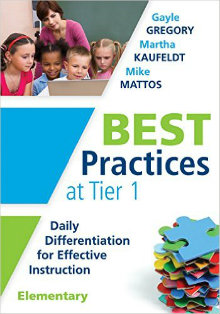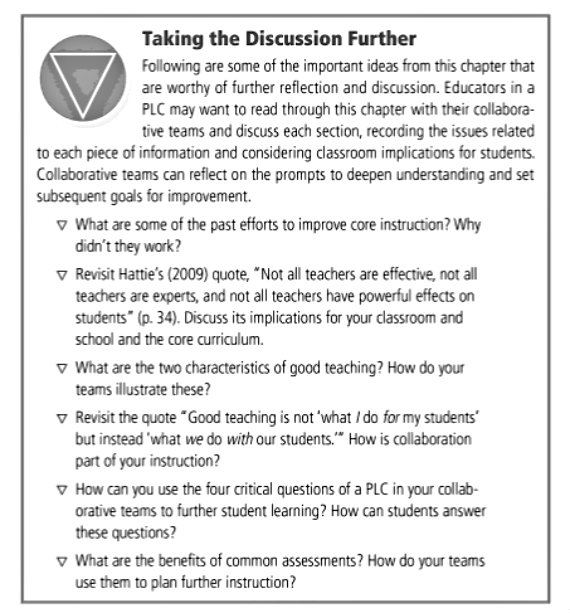Best Practices at Tier 1: Daily Differentiation
Best Practices at Tier 1: Daily Differentiation for Effective Instruction
By Gayle Gregory, Martha Kaufeldt, and Mike Mattos
(Solution Tree, 2015 – Learn more)
Reviewed by Linda Biondi


A powerful book for all educators
Authors Gayle Gregory, Martha Kaufeldt, and Mike Mattos have written a powerful book that is geared for all educators. Their book will help teachers learn how to create brain-friendly environments, develop a powerful core curriculum by shifting to a more collaborative instruction, apply differentiation strategies, and use data to inform instruction.
In sum, these interventions will increase the chance for student success and start helping students before they fall further behind. It is all about building success, one deliberate step at a time.
More about the book
The authors are very practical and sensitive to all teachers’ needs. They recognize that in order for optimum success to occur, there has to be a collaborative effort with a “guaranteed and viable curriculum and ongoing common formative assessment practices” (p.19) This quote spoke to me because many of the teachers I confer with are feeling overwhelmed. But when we chatted about RTI and the premise of the book, they said they felt reassured because they felt more empowered. Their thoughts, ideas, input, and data counted!
Effectively implementing RTI is not just a collaborative effort between teachers and administration, but with the students as well. We know the data that speaks to the importance of student input into their own learning. We know that it is important to empower them to be independent learners and advocates of their learning.
The authors remind us that everyone is a stakeholder, especially the student. We need to help them identify their own learning preferences and needs so that they will be partners in this journey. The authors help the teacher and the students manage this shift into creating “brain friendly environments.”
Table of Contents
Chapter 1: Shifting to Collaborative Core Instruction
Chapter 2: Creating Brain-Friendly Learning Environments
Chapter 3: Finding Each Student’s Learning Sweet Spot
Chapter 4: Developing a Powerful Core Curriculum
Chapter 5: Differentiating Instruction Through Pluralized Teaching Strategies
Chapter 6: Using Data to Inform Instruction
Chapter 7: Building Cognitive Rigor, Depth, and Complexity
Epilogue: Embracing the Journey
Read with your team
Just as teaching students is collaborative effort, teachers should read this book as a team. At the end of each chapter are questions and ideas that warrant further reflection and discussion. Brainstorming ideas with colleagues will bring a cross section of diverse experiences and backgrounds into play and increase the strength of ideas presented.
Copyrighted material
The authors are more than generous with their knowledge and resources. If you visit go.solution-tree.com/RTIatWork, most of the resources/tools in the book are included. All you need to do is to sign in! Not only are there links to the reproducibles that are used in each chapter, but also links to scientific articles and interactive sites for students and teachers such as Newsela and ABCya.
Teachers are constantly assessing and responding to data to drive their instruction. Many of the strategies and points addressed in the book were adaptable for all students at Tier 1. (The version I read is aimed at Grades K-5. Another version looks at Grades 6-12.)
As I was reading this book, I thought about how I could assess data about my own teaching and use it to drive my instruction. The book made me think about whether I am matching strategies to my students’ readiness levels. It challenged me to look at my differentiation practices to assess whether I am scaffolding my students’ learning and helping them become more independent thinkers who want to challenge themselves.
The discussion points in each chapter are an invaluable resource for staff development and individual professional development.
Worth the close read
I found that this book was not the type of book that I could read at the beach from beginning to end. It was not the type of book that I would read once and put away until I needed some data for a research paper. It was not the type of book that I could “flag” with Post Its of lessons or activities to use.
However, it was the type of book that I had to read closely, section by section, to savor. It was the type of book that I would mull over in my mind, come back to and reread, and share with my colleagues. It was the type of book that made me question my teaching, causing me to wonder about how I could be an even better teacher.
It was also the type of book that reminded me that I was not alone in my teaching journey. I wanted to share it with others and I highly recommend it to you.
Linda Biondi is a fourth grade teacher at Sharon Elementary School in Robbinsville, NJ, and a long-time Morning Meeting practitioner. She’s also the recipient of several educational grants, a Teacher Consultant with the National Writing Project and a participant on the NJ Department of Education Teacher Advisory Panel. Linda participates in ECET2 Celebrate Teaching which has posted an interview with her.





































